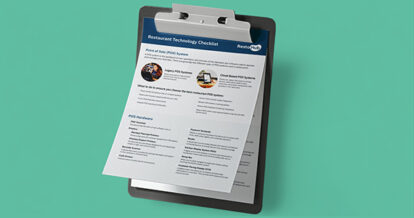Even if you’ve got the best food on the block, your restaurant’s customer service also needs to be top notch. Having a restaurant busser or two on every shift can help take the pressure off your serving staff and keep your operations running smoothly.
In this article, we’ll answer common questions about the busser position, including:
- What is a busser in a restaurant?
- What does a busser do?
- How much do restaurant bussers make?
- Do bussers get tips?
We’ll also share how you can hire your next rockstar restaurant busser following three simple steps.
What is a Restaurant Busser?
A restaurant busser is part of your front-of-house team. Sometimes referred to as a ‘busboy’ or ‘busgirl,’ their primary role is to keep tables clean by clearing dishes, wiping down tabletops, and resetting tables as needed.
What Does a Busser Do?
While restaurant bussers don’t interact with guests as frequently as servers do, they still play a crucial role in helping customers feel welcome and comfortable during their meal. A great busser will keep a keen eye on the dining room to clear plates away from tables as soon as a guest finishes eating.
Similar to how a bar back supports a bartender, a busser is like Robin to a server’s Batman – especially during busy periods. As strong multitaskers as servers are, they can’t be everywhere all of the time. So, bussers help keep servers out of the weeds, which in turn, keeps guests happy.
Main Busser Responsibilities
Restaurant busser job descriptions vary from venue to venue, but a few parts of the role remain consistent. Here’s a basic overview of a busser’s responsibilities:
- Removing dirty dishes and cutlery from tables when guests are finished eating
- Refilling water glasses for diners during service
- Helping servers with tasks like bringing side plates and sauce ramekins to guests
- Keeping the dining area clean during service – for instance, by wiping up spills and vacuuming as needed
- Promptly cleaning tables and resetting them with clean utensils, napkins, and condiment carts after guests leave
- Staying in communication with servers, hosts, and back-of-house team members to collaborative effectively and keep service running smoothly
- Ensuring the stock area is consistently topped up with clean linens, silverware, glassware, trays, dishes, etc.
When restaurant bussers take care of these tasks, servers can focus on quickly and accurately taking orders and bringing food to their guests, instead of spending all of their time running dirty dishes to the pit.

Download your customizable template now to start your own handbook for your restaurant!
How Much Do Bussers Make?
We’ve now answered the question, “What does a busser do in a restaurant?” and shared a list of key responsibilities to help you create your own restaurant busser job description. Next, let’s dive into salary information for the busser position.
As with any other role, you’ll want to make sure you offer competitive pay when hiring restaurant bussers. This way, you’ll be more likely to attract and retain qualified candidates who feel valued for their contributions to your team.
In the United States, restaurant bussers earn $11 an hour on average, with a typical wage range of $10 to $12 an hour. However, certain states have a higher minimum wage (for example, D.C.’s minimum wage is $17 an hour and California’s is $16), so depending on where your restaurant is located, you’ll need to adjust accordingly.
The busser wage is on par with similar front-of-house support roles like hosts and bar backs. Knowing and planning for this expense will help you accurately budget your labor costs to ensure they remain sustainable.

Do Bussers Get Tips?
Restaurant bussers don’t normally receive tips directly from guests. Instead, most diners in countries that practice tipping will leave a tip for their server when the time comes to pay their bill. However, that doesn’t mean bussers don’t receive any extra money for their hard work!
Bussers usually receive tips through the “tip out” process, which involves servers and bartenders sharing tips with other employees at the end of a shift. While not everyone on staff takes payment from guests, everyone does contribute to the overall dining experience. Tipping out ensures that each team member who plays a part in creating a stellar experience gets a fair slice of the pie for their efforts.
How Much Do Bussers Make in Tips?
Tipping systems vary from restaurant to restaurant, which means the amount bussers make in tips varies, too. One of the most common ways of handling tips involves servers tipping out as a percentage of their total tips.
In this case, bussers and other support staff receive a set percentage of each server’s total tips. For instance, a busser might receive 5%. Here’s a sample breakdown earnings for a Friday dinner shift:
- Server 1: earns $200 in tips and shares 5% ($10) with the busser.
- Server 2: earns $150 in tips and shares 5% ($7.50) with the busser.
- Server 3: earns $250 in tips and shares 5% ($12.50) with the busser.
The busser earned $30 in total tips that evening.

How to Hire a Busser for Your Restaurant in 3 Steps
Restaurant staffing is a pain point for many businesses, but hiring a busser doesn’t have to be a headache. Here are a few steps to help you streamline the process.
1. Write the Perfect Restaurant Busser Job Description
Browsing sample job descriptions is a great place to start, but ultimately, your busser job ad should reflect your restaurant’s unique needs. Be sure to consider this when crafting it.
We all know that restaurants are fast-paced environments, often requiring all hands on deck. So, do your best to clearly outline what kind of responsibilities busser candidates will be asked to fulfill. You may want to also include the fact that they’ll have to prepare for some odd jobs, too. Ultimately, your description of the role should clearly answer the question, “What does a busser do in a restaurant?”
Next, list the ideal qualities of a busser. Are you looking for team players with a positive attitude? Do you need someone who’s comfortable being on their feet for hours at a time? Clearly stating the soft and hard skills you’re seeking helps candidates self-assess their fit. It also ensures you attract applicants who align with your restaurant’s culture.
Finally, mention any perks or benefits you offer. Flexible scheduling, employee discounts, health benefits, or opportunities for growth can make the busser position more appealing to candidates. And don’t forget to clearly identify how people can apply, and by what date.
Busser Job Description Sample
| Position: Restaurant Busser Salary: $12 an hour Tip Income: 5% of servers’ tips Schedule: Part-time, Thursday to Sunday Are you a team player who loves putting a smile on guests’ faces by providing exceptional service? We’re looking for energetic individuals to join our front-of-house team as bussers! Previous hospitality experience isn’t necessary, but will be considered an asset. Need flexible scheduling? No problem. We’re proud to offer this, as well as employee discounts and opportunities for career development and growth. Responsibilities: – Removing dirty dishes and cutlery from tables when guests are finished eating – Refilling water glasses for diners during service – Helping servers with tasks like bringing side plates and sauce ramekins to guests – Keeping the dining area clean during service – for instance, by wiping up spills and vacuuming as needed – Promptly cleaning tables and resetting them with clean utensils, napkins, and condiment carts after guests leave – Staying in communication with servers, hosts, and back-of-house team members to collaborate effectively and keep service running smoothly – Ensuring the stock area is consistently topped up with clean linens, silverware, glassware, trays, dishes, etc. – Caring for menus by keeping them clean and organized, and replacing damaged or dirty pages Offering special silverware sets or highchairs to families with young children – Adjusting table layouts for large groups and moving heat lamps on patios as needed – Helping with closing duties like stacking chairs and preparing stations for the day shift – Ensuring compliance with health and safety regulations in all kitchen and dining areas – Remaining up-to-date with job-related knowledge by actively participating in staff training – Odd jobs as needed to help out the team Desired skills: – Team player with a positive attitude – Excellent communication skills – Adept at multitasking and prioritization – Calm under pressure – Takes initiative and anticipates the needs of colleagues – Possesses natural problem solving abilities – Navigates situations in a composed, professional way – Strong attention to detail – Willing to go the extra mile for guests This is a physically active role. Candidates must be able to clean tables and chairs; bend and kneel; vacuum, sweep, and mop; as well as be on their feet for most of their shift. They should also be capable of lifting at least 25 pounds. We invite interested applicants to apply by [date] by sending your resume to [email address]. Those who are qualified will be contacted for an interview. We can’t wait to hear from you! |
2. Filter for Experience
While experience isn’t always necessary for the role of a busser, candidates who’ve previously worked in restaurants or customer service roles may adapt more quickly to the demands of the position and require less training. So, consider adding a statement to your job description that experience in similar fast-paced environments (think restaurants, cafes, or hospitality settings) will be considered an asset.
Be careful to weigh the importance of experience against other factors like attitude, work ethic, and team culture fit when making your hiring decisions. You can teach new hires about duties and processes (that’s what your restaurant training manual is for!), but it’s hard to force a fit when one doesn’t seem to exist naturally.

Download this customizable restaurant training manual template to ensure a smoother onboarding and training process for staff.
3. Screen for the Right Skills
First and foremost, your new busser should be a team player. They also need to be adept at multitasking and prioritization, since it’s common for numerous issues to pop up all at once in a restaurant. They’ve got to be able to respond calmly and efficiently, addressing the most pressing tasks first and keeping in communication with other staff along the way.
A good busser also takes initiative and anticipates the needs of their server colleagues, replenishing supplies at side stations before they’re even noticed as running low. They must have natural problem solving abilities too, and be able to navigate situations with guests in a composed, professional manner.
Attention to detail, a positive attitude, and the willingness to go the extra mile for guests are a few other critical skills to screen for. After all, you’re in the business of making customers happy!
Keep in mind that you can look for transferable skills from other industries. And you can always ask more about a candidate’s skills and experience in your restaurant interview questions when you sit down with the applicants on your short list.
We’ve now answered the question, “What is a busser in a restaurant?” and provided salary information plus hiring tips. By following these steps, you’ll be well on your way to building a strong team of bussers who can help you deliver outstanding guest service. Happy hiring!
Download your free employee handbook template
Sign up for our free weekly TouchBistro Newsletter







